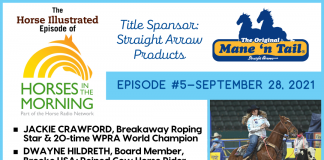 An ill-fitting saddle can cause training and behavior problems as well as unsoundness in the horse’s back. While many riders are aware of the importance of saddle fit, no scientific evaluation of western saddle fit had been published until recently. The New Mexico State University National Agri-Marketing Club released the results of its study on the fit of roping and barrel saddles, and the findings show that a large percentage of riders do not have properly-fitting saddles.
An ill-fitting saddle can cause training and behavior problems as well as unsoundness in the horse’s back. While many riders are aware of the importance of saddle fit, no scientific evaluation of western saddle fit had been published until recently. The New Mexico State University National Agri-Marketing Club released the results of its study on the fit of roping and barrel saddles, and the findings show that a large percentage of riders do not have properly-fitting saddles.
In addition to pressure points, the researchers also looked for signs of bridging, or a gap in contact between the front and back of the saddle. A saddle with proper fit would be characterized as one with fairly consistent contact from end to end with no excessive pressure points.
Roping Saddle Fit
In the sample of roping saddles, 41.3% showed saddle bar pressure higher than 3.6psi. 26.9% showed spinal process pressure in the harmful levels. Fit problems were far more likely to occur at the front of the saddle, with 93% of poorly fitting saddles showing pressure points at the pommel. Nearly three-quarters of those saddles showed more pressure on the left side than the right.
Bridging was also found to be an issue with 84.6% of the roping saddles.
Barrel Saddle Fit
Nearly half of the barrel saddles in the study (49%) showed excessive pressure from the saddle bars. All but one of the saddles that showed excessive bar pressure showed it occurring in the front. Pressure points were fairly evenly distributed across the left and right sides. 16.3% of barrel saddles showed spinal pressure.
93.9% of the sample population of barrel saddles showing some bridging. The researchers did not offer reasoning for why bridging would be more common in barrel saddles than roping.
 |
| Harmful pressure is indicated by the red in the scan on the left from an FSA mat. The scan on the right shows a well-fitted saddle with fairly even weight distribution and no pressure points. Image courtesty NMSU’s National Agri-Marketing Club. |
Other Factors
The researchers found a correlation between pad thickness and poor fit. Riders who used thicker pads were actually more likely to have fit problems, where each inch of pad thickness increased the likelihood of poor fit by 23.3%. Researchers cite the so-called “pad paradox” as the reasoning for this. The theory behind the pad paradox is that riders incorrectly believe a thicker pad will be more comfortable for their horse, while in reality a thick pad lifts the front and rear of the saddle by different amounts because the bar angles are different in the front and back. This variation contributes to the problem of bridging.
The weight of the rider affected the fit of roping saddles. Riders in the roping saddle study ranged from 125 lbs to 250 lbs with a mean weight of 170.8. Researchers found that each additional pound of weight increased the probability of poor fit by 0.5%. The same issue was not found in barrel saddles. The weight issue comes into play when bridging is also an issue, and bridging is far more common in roping than barrel saddles. The researchers theorize that solving the bridging problem would also alleviate problems caused by rider weight, except in extreme cases.
Read the full report here.
Read more on tack fit here.






I just had my horse’s chiropractor come out and check my saddle fit. She told me that my pad was too thick and too big. I bought a new pad and I can really see the difference in the way the saddle fits. It’s really interesting how a thicker pad isn’t usually the answer.
Interesting. I have a saddle that was leaving pressure dry spots on one mare with a thicker pad. I switched to a thinner pad and now the mare has sore shoulders and withers.
I wonder what the studies would show with English saddles.
you could try two thinner pads on top of each other unless you’ve already found out a way.
I would like to know if these test were done with the horses in motion,we’re they roping at the time,turning a barrel, stopping? There are so many reasons a saddle fits poorly, one of those reasons is the horse is not in good shape (overweight / underweight )as a saddle maker I study these ,not to be judgemental,but to get as much input to build qualty,proper fitting ,and comfortable saddles. Please feel free to share your input with me or if you have the study please send it to joelforrestsaddles@yahoo.com thank you.